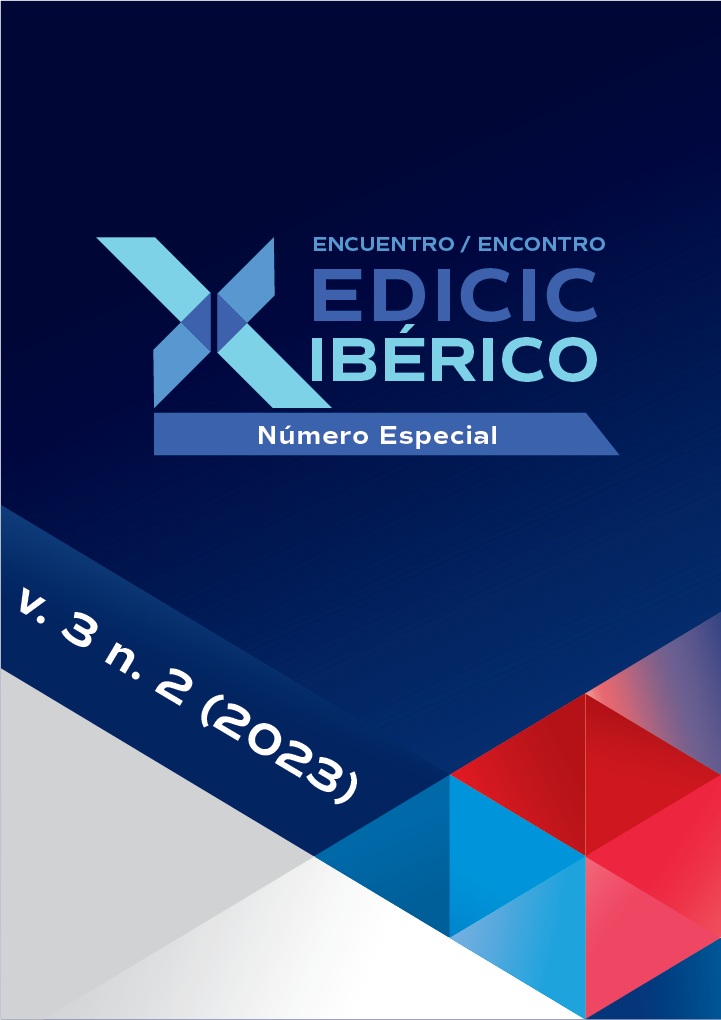Notion of text and information representation: an application based on discursive semiotics
DOI:
https://doi.org/10.62758/re.v3i2.240Keywords:
Document Analysis, Text, Discourse, Enounce, Discrusive SemiotisAbstract
The Organization of Knowledge, more precisely the Organization of Information, includes procedures for representing informational objects through concepts translated into specialized languages, which allows the future retrieval and use of documents. In this scenario, there is the extraction of information from the documents, the so-called keywords, which run through practices, strategies and methods that enable the analysis and treatment of documents. However, treatment and documentary analysis are carried out at the textual level, and since every text is the manifestation of a discourse, for its understanding and representation it is necessary to go through the processes of meaning that are verified through textual resources, enunciation and from the discourse itself present in the plane of expression, it is understood that the traditional document analysis is restricted to the selection of keywords, which is reduced in the semiotic analysis to the level of the sign as theme-image, repetitive and conditioned practice of professional doing. The Organization of Knowledge is a field that involves technical, methodological, practical, and epistemological factors, which allow debates about knowledge and its organization and representation, as well as the processes and products to carry out the activities of treatment, analysis, description, and production of instruments able to categorize and index informational objects. Therefore, it is important to debate the procedure of analysis and document treatment and for its interpretation, resort to semiotic theories that approach the discourse in which the meaning is verified through the generative path of expression, evidencing the relationship between sign, phrases and propositions in the elaboration of the utterance and the meaning manifested in the utterance verified by the cohesion, coherence and congruence, enabling the recognition of the meaning that takes place at the level of discourse. In this way, we seek to understand the notion of text and the representation of information as part of a discourse. Therefore, it is understood that the French line of semiotics, mainly the one proposed by Greimas, presents methodological and technical resources to analyze and understand the notion of text as part of the discourse, with every representation of information being a part of the discourse decoded into words- key used in the search and recovery of informational objects. The article presents a qualitative methodology, based on the analysis of concepts and bibliographical research carried out in the Dialnet database of theoretical foundations on the notion of text, treatment and document analysis, indexing, utterance, enunciation, and discourse. It is concluded that discursive semiotics is able to offer the Organization and Representation of Information and Knowledge mechanisms of interpretation based on semiotics, in order to guarantee that it promotes semantic and cognitive relations with the scientific properties of the document to deal more effectively with and blunt the manifesting information at the discursive level.
References
Almeida, C. C. (2011). Elementos de linguística e semiologia na organização da informação. São Paulo: Cultura Acadêmica.
Almeida, C.C. (2012). Mediação como processo semiótico: em busca de bases conceituais. Tendências da Pesquisa Brasileira em Ciência da Informação, 5, 1-18.
Almeida, C. C. (2010, Setembro 28–01). Sobre o pensamento de Peirce e a organização da informação [Anais]. Encontro Nacional de Pesquisa em Ciência da Informação, 9. Rio de Janeiro, RJ, Brasil.
Badir, S. (2005). A noção de texto em Hjelmslev. CASA: Cadernos de Semiótica Aplicada, 3(2).
Baquião, R. C. (2011). Signo, significação e discurso. Estudos semióticos, 7(2), 52-62. https://dialnet.unirioja.es/servlet/articulo?codigo=576214. DOI: https://doi.org/10.11606/issn.1980-4016.esse.2011.35250
Barros, D. L. P. (2008). de Preconceito e intolerância em gramáticas do português. In: Barros, D. L. P.; Fiorin, J. L. (Org.). A fabricação dos sentidos: estudos em Alfa, São Paulo, 53 (2): 351-364.
Barros, C. M., Café, L. M. A., & Almeida, C. C. (2013, Outubro 29–01). Informação musical e interpretação: contribuições semióticas para o campo da organização do conhecimento. [Anais]. Encontro Nacional de Pesquisa em Ciência da Informação, 14, Florianópolis, SC, Brasil.
Barthes, R. (2004). Texto (teoria do). In R. Barthes, Inéditos (pp. 261-289). Martins Fontes. https://iedamagri.files.wordpress.com/2020/02/aula5_barthes-teoria-do-texto.pdf.
Evangelista, I. V., Guimarães, J. A. C., & Almeida, C. C. (2014, Outubro 27–31). A semiótica como subsídio para a representação do conhecimento: uma análise conceitual sobre o tema [Anais]. Encontro Nacional de Pesquisa em Ciência da Informação, 15. Belo Horizonte, MG, Brasil.
Fiorin, J. L. (1999). Sendas e veredas da semiótica narrativa e discursiva. DELTA: Documentação De Estudos Em Lingüística Teórica E Aplicada, 15(1), 177–207. https://doi.org/10.1590/S0102-44501999000100009. DOI: https://doi.org/10.1590/S0102-44501999000100009
Fontanille, J. (2008). Prácticas semióticas. Trad. Trad. Desiderio Blanco. Lima: Universidad de Lima, Fundo Editorial.
Fontanille, J. (2012). Semiótica y literatura: ensayos de método. Trad. Desiderio Blanco. Lima: Universidad de Lima, Fundo Editorial.
Fontanille, J. (2019). Semiótica discursiva. Trad. Jean Cristtus Portela. 2ª ed. São Paulo: Contexto.
Friedman, A., & Thellefsen, M. (2011). Concept theory and semiotics in knowledge organization. Journal of Documentation, 67(4), 644-674. DOI: https://doi.org/10.1108/00220411111145034
González Montero, J. A. (2005). De la palabra/oración al texto/discurso. EA, (8), 195-230. https://ea.ceuandalucia.es/index.php/EA/article/view/139/115.
Hjelmslev, L. (2013). Prolegômenos a uma teoria da linguagem. Trad. J. Teixeira Coelho Netto. São Paulo: Perspectiva.
Ilari, R. (2018). O estruturalismo linguístico : alguns caminhos. In A. C. Bentes (Ed.), Introdução à linguística : fundamentos epistemológicos (pp. 53-92). Cortez. https://edisciplinas.usp.br/pluginfile.php/5611466/mod_resource/content/1/texto_estruturalismo_ilari.pdf
Izquierdo Alonso, M. (2000). Nuevos enfoques en el estudio del tratamiento documental de contenido desde los presupuestos de las ciencias del langue. Scire, 6(1), 143-163. DOI: https://doi.org/10.54886/scire.v6i1.1129
Izquierdo Alonso, M. (2004). Nuevos retos en el análisis documental de contenido: gestión de la forma documental del contenido. Scire, 10(1), 31-50. DOI: https://doi.org/10.54886/scire.v10i1.1477
Izquierdo Arroyo, J. M. (1990). La ciencia de la búsqueda documental secundaría. Documentación de las Ciencias de la Información, (13), 87-111.
Izquierdo Arroyo, J. M. (1993). De la semiótica del discurso a la semiótica documental. In J. A. Moreno González (Ed.), Aplicación de las ciencias del texto al resumen documental (pp. 199-216). Universidad Carlos III.
Lara, M. L. G. (1993). Algumas contribuições da semiología e da semiótica para a análise das linguagens documentárias. Ciência da Informação, 22(3), 223-226.
Lara, M. L. G. (2006). É possível fala rem signo e semiose documentária?. Encontros Bibli, (2), 18-29. http://www.periodicos.ufsc.br/index.php/eb. DOI: https://doi.org/10.5007/1518-2924.2006v11nesp3p18
Lara, M. L. G. (2001). O unicórnio (o rinoceronte, o ornitorrinco…), a análise documentária e a linguagem documentária. DataGramaZero, 2(6). http://www.dgz.org.br/dez01/Art_03.htm
Lara, M. L. G. (2000, Novembro 6–10). Representação e linguagens documentárias: bases teórico-metodológicas. [Anais]. Encontro Nacional de Pesquisa em Ciência da Informação, 4. Brasília, DF, Brasil.
Mai, J-E. (1997). The concept of subject: on problems in indexing. In I. C. McIlwaine (Ed.), Knowledge organization for information retrieval (pp. 60-67). FID.
Mai, J-E. (2001). Semiotics and indexing: an analysis of the subject indexing process. Journal of Documentation, 57(5), 591-622. DOI: https://doi.org/10.1108/EUM0000000007095
Mai, J-E. (2000). The subject indexing process: an investigation of problems in knowledge representation. [Tese doutorado, University of Texas at Austin]. Faculty of Graduate School of Library and Infomacion Science.
Mendes, C. M. (2018). Semiótica discursiva e comunicação: questões sobre linguagem, texto e interação. Estudos semióticos, 14(3), 16-32. DOI: https://doi.org/10.11606/issn.1980-4016.esse.2018.149044
Mendes, C. M. (2011). Da linguística estrutural à semiótica discursiva: um percurso teórico-epistemológico. Raído - Revista Do Programa De Pós-Graduação Em Letras Da UFGD, 5(9), 173–193. https://ojs.ufgd.edu.br/index.php/Raido/article/view/975.
Molon, N. D., & Viana, R. (2012). O círculo de Bakhtin e a Linguística Aplicada. Revista de Estudos do Discurso, 7(2). https://www.scielo.br/j/bak/a/SKstZ8JH7M66mxQ7RnncZ7j/ DOI: https://doi.org/10.1590/S2176-45732012000200010
Moraes, L. (2020). A noção de texto na semiótica: do texto-absoluto ao texto-objeto. Estudos semióticos, 16(3), 233-251. DOI: https://doi.org/10.11606/issn.1980-4016.esse.2020.162157
Moura, M. A. (2006). Ciência da informação e semiótica: conexão de saberes. Encontros Bibli, (2), 1-17. http://www.periodicos.ufsc.br/index.php/eb. DOI: https://doi.org/10.5007/1518-2924.2006v11nesp3p1
Moura, M. A., Silva, A. P, & Amorim, V. R. (2002). A concepção e o uso das linguagens de indexação face às contribuições da semiótica e da semiologia. Informação & Sociedade, 12(1), 1-22. http://www.informacaoesociedade.ufpb.br/issuev12n102.htm.
Pereira, S. V. M. (2018). O lugar do texto e do discurso em teorías enunciativas e discursivas. Scripta, 22(44), 189-202. DOI: https://doi.org/10.5752/P.2358-3428.2018v22n44p189
Salzedas, N. A. M., & Paccola, R. A. (2017). Texto: uma busca de definição. Estudos linguísticos, 46(3). DOI: https://doi.org/10.21165/el.v46i3.1726
Saussure, F. (2006). Curso de linguística geral. Trad. Bras. Antônio Chelini et al. São Paulo: Cultrix.
Schwartzmann, M. N. (2018). A noção de texto e os níveos de pertinência da análise semiótica. Estudos semióticos, 14(1), 1-6. https://dialnet.unirioja.es/servlet/articulo?codigo=6340750. DOI: https://doi.org/10.11606/issn.1980-4016.esse.2018.144288
Sirvent Ramos, M. A. (1987). Em torno al texto: el texto como significancia. Anales de filología francesa, (2), 147-156. https://dialnet.unirioja.es/servlet/articulo?codigo=206043.
Smith, G. F. (2011). Aspecto lexicográfico de los términos texto, discurso e enunciado en los diccionareios generales. Revista de lexicografía, (17), 15-31. https://dialnet.unirioja.es/servlet/articulo?codigo=4043086. DOI: https://doi.org/10.17979/rlex.2011.17.0.3781
Tálamo, M. F. G. M, & Lara, M. L. L. G. (2006). O campo da lingüística documentária. Transinformação, 18(3), 203-211. DOI: https://doi.org/10.1590/S0103-37862006000300004
Thellefsen, T. L. (2003). Pragmaticism and the role of terminology. Impact. http://www.impact.hum.auc.dk.
Thellefsen, T. L. (2002). Semiotic knowledge organization: theory and method development. Semiotica, 142(1/4), 71-90. DOI: https://doi.org/10.1515/semi.2002.086
Thellefsen, T. L. (2004). Knowledge profiling: the basis for knowledge organization. Library Trends, 52(3), 507-514.
Thellefsen, T. L., & Thellefsen, M. M. (2004). Pragmatic semiotics and knowledge organization. Knowledge Organization, 31(3), 177-187.
Downloads
Published
How to Cite
Issue
Section
License
Copyright (c) 2023 Revista EDICIC

This work is licensed under a Creative Commons Attribution 4.0 International License.
The Association holds the copyright of the texts it publishes and, therefore, adopts a Creative Commons License, CC BY 4.0 DEED Attribution 4.0 International (https://creativecommons.org/
You are free to:
- Share: copy and redistribute the material in any medium or format for any purpose, even commercially.
- Adapt: remix, transform, and build upon the material for any purpose, even commercially.






